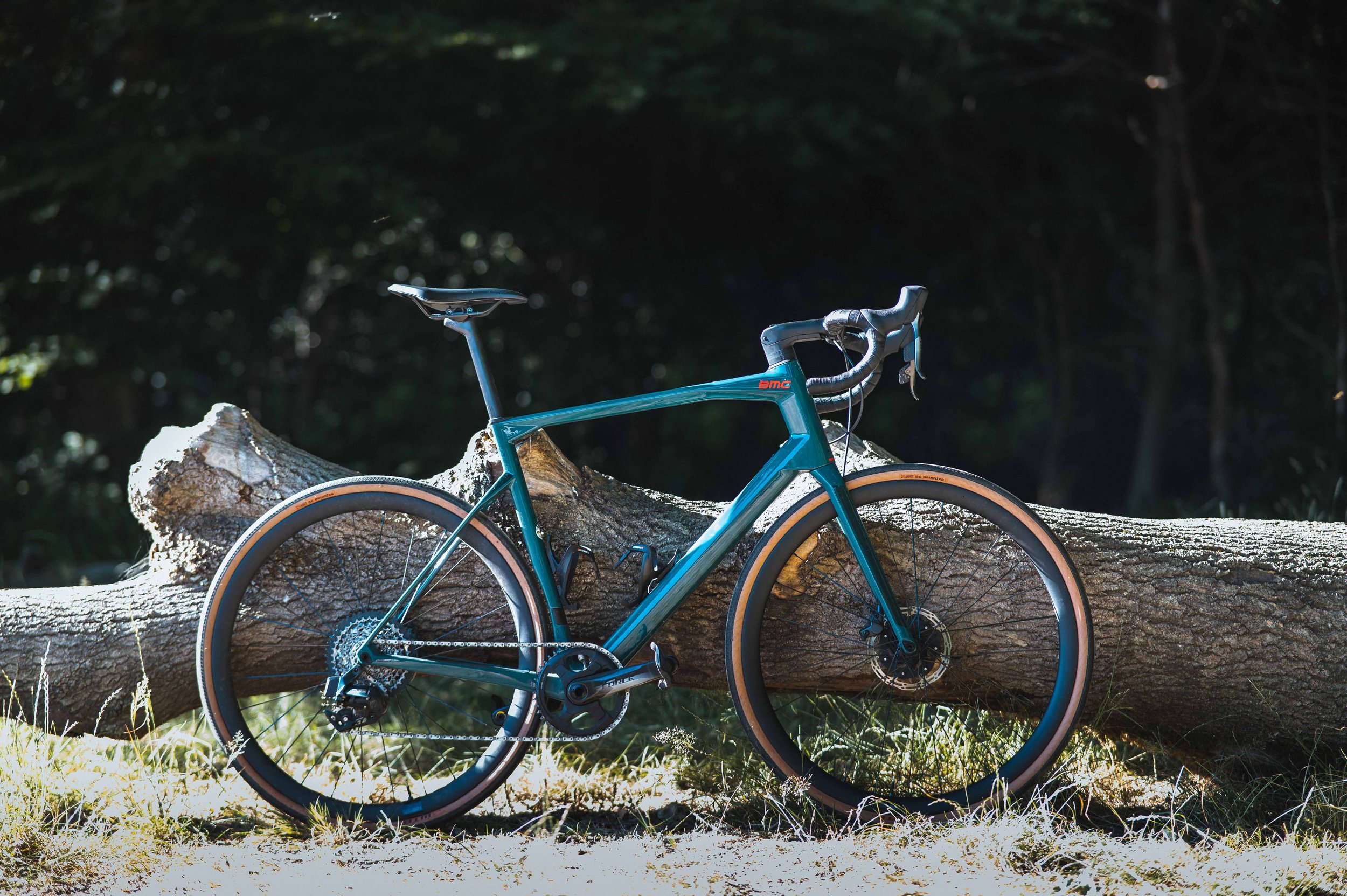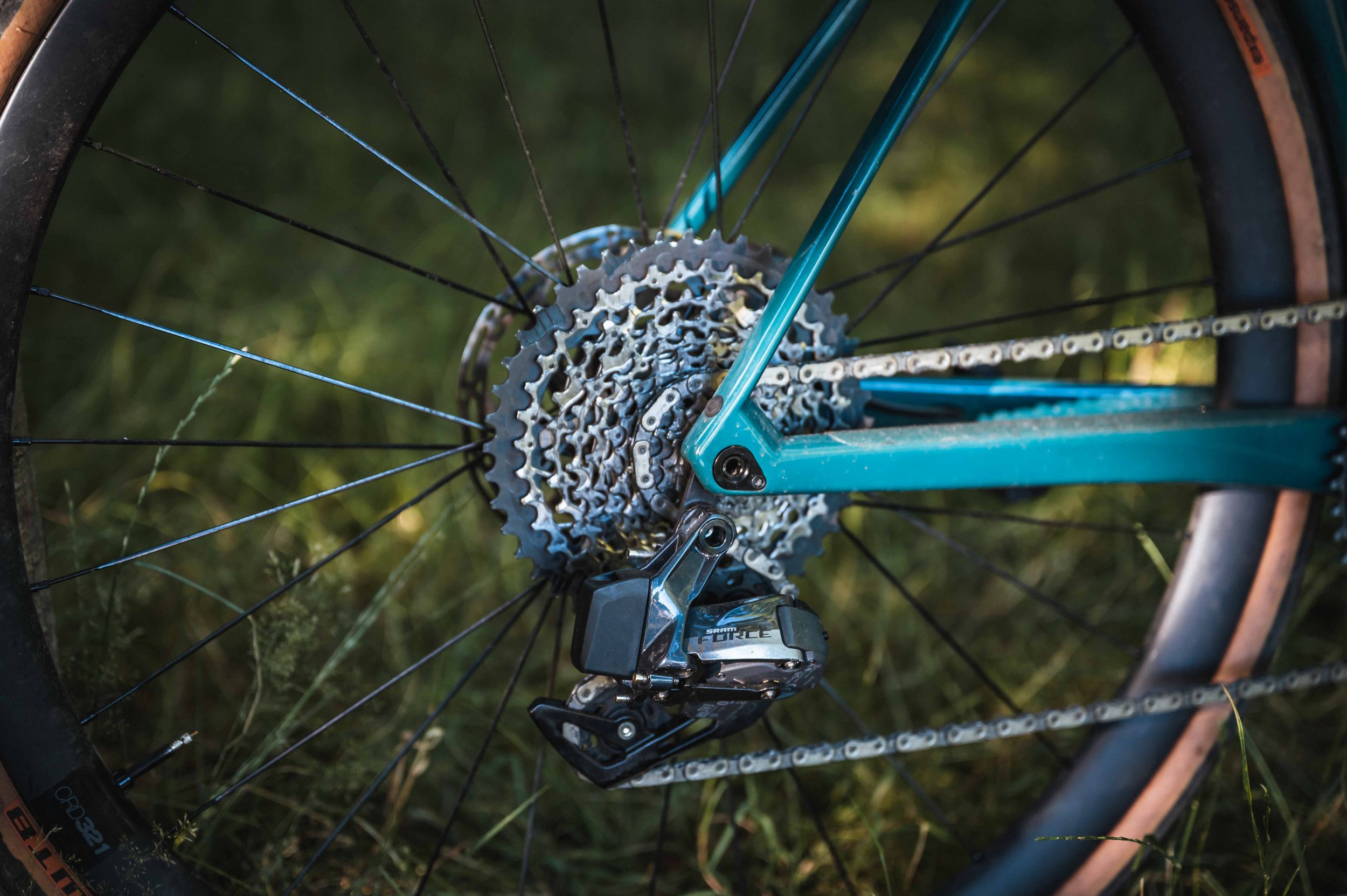BMC Roadmachine X Review
4.5/5
£4999 | Buy from BMC
TL:DR
A jack of all trades is a great way of describing the Roadmachine X, it might not be a master of all but it comes pretty close to being a perfect one bike garage. It devours tarmac like few things we’ve ridden before and left us feeling fresher at the end of 4 hour rides bit also can keep up with the gravel specific bikes when the tarmac turns to dust although it’ll struggle on singletrack and technical terrain. Shifting is taken care of by SRAM’s excellent AXS Force and we can understand the glowing praise surrounding electric gears.
If we didn’t have a garage full of bikes already, we’d strongly consider purchasing one.
Positives
Smooth, compliant ride
Stiff frame in the right places
SRAM shifting is excellent
Tan wall tyres make everything look better
Negatives
Large jumps between gears
Not fully internal cabling
Large volume tyres didn’t handle as sharp as I’d like.
The Lowdown
SRAM Force AXS Groupset
35mm tubeless ready carbon wheelset
32mm WTB Tyres
Mash up of road and gravel geometry
Carbon seatpost, alloy bars.
Over the past years, cyclists have been greeted with an overwhelming choice when it comes to buying a new bike; we’re not talking about choosing between a road or mountain bike, or even road vs gravel; we’re talking about the multitude of niches that exists under just the road bike moniker.
In the mid 2010’s punters bemoaned the fact they had to choose between an aero bike or a lightweight ‘climbing’ but shoot forwards to 2022 and we’ve got aero, lightweight, comfort and all road bikes to choose between, and that’s before opening the Pandora’s box of gravel bikes.
So when we pulled the BMC Roadmachine X One from its box, we were a bit confused as to what this bike was actually for. See, the 32mm wide tyres implied it might be good for smashing out the miles over smooth gravel, but the reasonably tight ratios on the cassette painted a picture of fast group rides through the countryside.
It took us a while to get a feel for the Roadmachine X, but when it finally clicked it all made sense. BMC explicitly said it wasn’t a gravel bike, so what did we do? Take it to the Cairngorms to thrash around some of the finest roads and, err gravel, the UK has to offer.
First impressions of BMC’s new steed were positive; the subtle yet classy paintjob oozed understated luxury and the wireless SRAM AXS Force groupset meant the front end was incredibly tidy save for the externally routed hydraulic hoses. It’d be great to see these fully integrated, but it does make maintenance easier having them on show. The other thing that stood out to us was the full carbon wheelset. They may only have been 35mm in depth and BMC’s in house brand, but they looked great and completed a solid package.
The first few pedal strokes on the Roadmachine X made its intentions clear; this wasn’t some softened up road bike with big pillowy tyres. Far from it, the frame was stiff in all the right places and the bottom bracket had no perceivable flex, even when this tester was stamping on the pedals in the wrong gear up a steep hill which often weeds out the flexy frames. The carbon hoops were also remarkably sturdy too, we couldn’t detect any tyre on frame rubbing action when out of the saddle and they’re remained straight and true after a couple of hundred kilometres being pummelled by potholes and fire roads. The bolt through axles front and rear also contribute to the overall stiffness but make sure to take a multitool as you’ll need one in case of a puncture.
It wasn’t all rigid thought, there was a remarkable amount of compliance in the rear end which made riding over broken surfaces a lot less fatiguing after multiple hours in the saddle. A large part of this likely comes down to the 32mm wide WTB Expanse tyres, which when pumped up to 70psi provided the optimal balance between rolling speed and compliance. Thanks to them being set up tubeless already, we could have probably flirted with lower pressures, but we did find that under hard cornering there was a bit of hesitancy to turn in which was probably down to the generous sidewalls. A split second later they’d be grippy as anything though, so we didn’t have to change our riding style, it was just a bit unnerving the first few times leaning the bike hard into a corner and seemingly nothing happening for an instant. All in all the trade-off between ride comfort and razor sharp handling is a welcome one, after all this isn’t a crit bike.
BMC were very clear that this isn’t a gravel bike so naturally we took it on a gravel loop around the Cairngorms to see how far we could push it. A long way is the answer, it was only unsettled on some very rocky parts of the route which wouldn’t have been straightforward for even a full suspension mountain bike. Aside from this, the Roadmachine X cruised along a fair pace on the smoother gravel and the road sections were dispatched without issue. The gearing was the only thing that held us back slightly; due to it being predominantly a road bike the gear ratios are quite tall, so steeper sections of trail had to be attacked otherwise you’d quickly end up grinding away.
We can’t help but think a pair of carbon bars would help to smooth out rough surfaces even more but as they aren’t propriety or require any internal routing, it’ll be possible to fit almost any carbon bar to the Roadmachine X. The D profiled carbon seat post took some of the sting out of rough roads too although we weren’t a huge fan of the Fizik Terra Argo saddle which seems to be specced on several similar bikes. Bizarrely, the same saddle was on the 3T RaceMax we reviewed a few weeks ago and had no grumbles with it there so it’s probably down to the slightly longer top tube on the BMC which rotated our pelvis forward more. Saddles are a very personal contact point on a bike so it feels a bit harsh to mark it down for that.
You’d be thinking up to this point that the Roadmachine X would be a perfect companion to take on long days in the saddle which it would be but turn the pedals in anger and the frame comes alive with what feels like every revolution the bike surging forwards. It’s not on the same level as a dedicated road bike but it could certainly hang on to a fast group ride without too much fuss. A few frame details provide a hint at what BMC intentions are with the bike; mounts on the top tube for a bento box and double bottle mounts means hydration and snack storage are catered for.
One of the standout features of the Roadmachine X is the groupset; shifting and braking is dealt with by SRAM’s exceptional Force AXS groupset. We’d never really understood the hype around electric gears; we’d never actually ridden a bike with them before the Roadmachine X but we’d always thought what’s wrong with gear cables and indexing.
It’s less what’s wrong with the traditional setup because the answer is not much and more what can be done better. Traditional setups require precise indexing and heaven forbid the cable is sticky or the mech hanger takes a light knock; your beautifully crisp and accurate gears become crippled into a noisy and frustrating mess.
It’s in these situations where electric gears come into their own; sticky cables are banished with wireless signals and because the movement of the mech is no longer controlled by an indexed cable, the mech can move different amounts between cogs on the cassette meaning it can account for bent mechs. We wedged the Roadmachine X into the back of our car on multiple occasions and every time the gears still worked flawlessly.
We found shifting with SRAM’s second tier groupset a joy, shifts were accurate and blazingly fast; the shifters could even be reconfigured to change different number of gears with different lengths taps thanks to the SRAM AXS app. We had our shifters configured so the left shifter shifted up the cassette and the right went down which worked very intuitively.
The Roadmachine X uses a single chainring on the front and a wide spread cassette on the rear to give you similar overall ratios to a 50-34 with an 11-28 just with larger jumps between the gears. This worked very well 95% of the time and the only time we wished for smaller jumps between the cogs was when pushing into headwinds or along false flats. We occasionally struggled to find the right gear and either ended up spinning too fast or really labouring and struggling to get on top of the gear.
Braking was similarly uneventful; the hydraulic disks were powerful and offered plenty of modulation and control. We did find that the level pulled quite close to the bar, so much so that we’d occasionally get our finger stuck behind the shift paddle when braking hard. It’s likely they just needed bleeding to get them back to normal. The bite point was easily adjustable with a 5mm hex key under the brake hood.
The ergonomics of the shifters were very pleasant too; slightly larger than Shimano’s offering but that’s no bad thing as it gave us something more to hang onto when the road got bumpy.
The only downside of electric gears is you need to remember to charge them and we can’t say we remembered to and certainly didn’t get stuck 20km into the Cairngorms with not a person in sight, let alone a bike shop with an AXS charger… SRAM reckon the mech batteries are good for about 60 hours of riding and they can be charger up fairly rapidly if you remember the charger.
The battery clips securely onto the rear mech and the shifters are powered by traditional coin cells which last for around 2 years. When the shifter does run out of puff, it’ll simply stop working rather than use its final few gasps of life to shift you into an easier gear so it’s possible you could get stuck in a mighty gear if like us you do forget to charge your battery. Luckily for us we were in a low gear when it ran out of juice so we did our best Chris Froome impression of pedalling at 120rpm on the ride home.
When we dragged the Roadmachine X out of its box we were a bit baffled at what it was actually for. It didn’t look as fast as a road bike yet didn’t look as capable as a gravel bike so where would you ride the thing? The answer is, rather unhelpfully, everywhere. It’ll eat up miles on the road as easily as it does off it; we wouldn’t suggest taking it on super gnarly gravel routes but it’ll cope with fire roads and the smoother end of gravel. We loved being able to string our normal road routes together with some light gravel to make a stimulating ride and the Roadmachine X meant that we weren’t compromised on either. Throw some deeper section wheels and dedicated road tyres and it’ll be able to keep up with the pure road bikes. If we were forced into only having one bike in the garage, the Roadmachine X would be very near the top of the list for the bike that can do it all.









